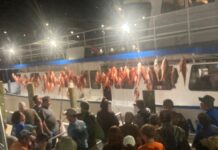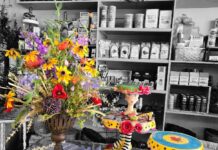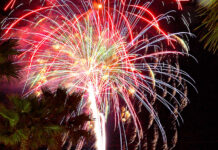 By Julie McConnell, UF/IFAS Extension
By Julie McConnell, UF/IFAS Extension
I must admit I absolutely love southern magnolias, but I understand they are not popular with every gardener. They grow quite large, their thick, evergreen leaves are difficult to rake, and roots may surface causing issues in confined spaces. I get it, it is not the tree for everyone, but before you discount the entire Magnolia Family let me introduce you to some less popular cousins that you should really consider adding to your landscape.
 There are over 200 species in the Family Magnoliaceae commonly referred to as the Magnolia Family. They consist of deciduous, semi-evergreen, and evergreen shrubs and trees. Magnolias have fuzzy leaf and flower buds and in some species these hairs are a rusty brown which is another ornamental feature. Magnoliaceae is an old botanical family, dating back 95 million years! The flowers are large, fragrant, and bowl shaped to attract their ancient pollinators – beetles, which predate bees and other modern pollinators. Most magnolias thrive in slightly acidic, well-drained soil with full sun to part shade. More sun enhances flowering, but with the late winter blooming types avoid southern exposure to reduce the likelihood of early blooms that may be damaged by frost.
There are over 200 species in the Family Magnoliaceae commonly referred to as the Magnolia Family. They consist of deciduous, semi-evergreen, and evergreen shrubs and trees. Magnolias have fuzzy leaf and flower buds and in some species these hairs are a rusty brown which is another ornamental feature. Magnoliaceae is an old botanical family, dating back 95 million years! The flowers are large, fragrant, and bowl shaped to attract their ancient pollinators – beetles, which predate bees and other modern pollinators. Most magnolias thrive in slightly acidic, well-drained soil with full sun to part shade. More sun enhances flowering, but with the late winter blooming types avoid southern exposure to reduce the likelihood of early blooms that may be damaged by frost.
Sweetbay Magnolia (Magnolia virginiana): Sweetbay magnolias are native to North America, including the Florida Panhandle. This semi-evergreen tree has oval olive-green leaves with silver on the underside. Fragrant white flowers in the summer are followed by cones with bright red fruit in the fall. A medium sized tree, sweetbay magnolia grows 50-60’ tall by 15-25’ wide and may be sold as a multi-trunk tree. This adaptive tree is found along streambanks and in floodplains which means it is a great option for poorly drained soil or yards that flood occasionally.
Star Magnolia (Magnolia stellata): White, fragrant, star-shaped flowers consisting of 12-18 narrow tepals gives this magnolia its name. Star Magnolias are small deciduous trees that bloom in the late winter/early spring. Growing 15-20’ tall by 10-15’ wide they have a bushy growth habit that can be utilized as a focal point rather than a shade tree. Fruit are cones with orange seeds and if weather conditions line up just right you may get yellow fall color. Star Magnolias originated in Japan and have been used in the United States since the 1860s.
Jane Magnolia (Magnolia ‘Jane’): This deciduous magnolia with purple-pink tulip shaped flowers is part of the National Arboretum Little Girl series created by Francis DeVos and William Kosar crossing Magnolia liliiflora and Magnolia stellata ‘Rosea’ in the 1950s. Jane and the other Little Girls bloom March-April in our area, usually avoiding frost damage to tender flowers. Another shrubby tree, Jane grows 12-15’ tall x 10-12’ wide.
Banana Shrub (Magnolia figo): Banana shrub gets its name from the creamy flowers that smell like ripe bananas! This large evergreen shrub grows from 6-15’ tall by 6-8’ wide and makes a perfect screen or backdrop for smaller plants. In addition to the aesthetic qualities, this native of Korea and Southeast China is also salt tolerant and is suited to coastal landscapes.
Fairy Magnolia® ‘Blush’ (Michelia doltsopa ‘Fairy Blush’): Fairy Blush Magnolia is an evergreen shrub maturing at 5-10’ by 4-6’ wide. Dark brown fuzzy flower buds are followed by creamy flowers with petals edged in pink and a faint blush. Flowers are fragrant and can be found all along the stems, making it a showstopper in the late winter.
To learn more about magnolias and other great plants for Florida visit https://gardeningsolutions.ifas.ufl.edu/plants/
An Equal Opportunity Institution. UF/IFAS Extension, University of Florida, Institute of Food and Agricultural Sciences, Andra Johnson, Dean. Single copies of UF/IFAS Extension publications (excluding 4-H and youth publications) are available free to Florida residents from county UF/IFAS Extension offices.

















































